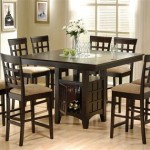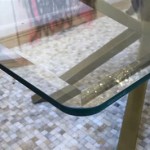Decorating Dining Room Table Ideas: A Comprehensive Guide
The dining room table serves as a focal point in any home, often the gathering place for meals, conversations, and celebrations. Its decoration, therefore, is crucial in setting the atmosphere and enhancing the overall aesthetic of the dining space. Thoughtful table decor can transform a simple meal into a memorable experience, reflecting personal style and creating a welcoming environment for family and guests. This article explores various decorating ideas for the dining room table, focusing on elements that contribute to both visual appeal and functional harmony. Understanding the principles of design and considering practical aspects will enable one to create a dining table setting that is both beautiful and conducive to comfortable dining.
Understanding the Foundation: Table Size and Shape
Before embarking on the decorative process, it's essential to consider the size and shape of the dining room table. These fundamental characteristics dictate the scale and arrangement of decorative elements. A large, rectangular table, for example, lends itself well to a long, linear centerpiece or a series of smaller arrangements placed along its length. A round table, on the other hand, often benefits from a single, central focal point to maintain balance and visual harmony. A square table presents unique opportunities for symmetrical arrangements or a more modern, minimalist approach. The table's dimensions directly influence the size and quantity of decorations, ensuring that the setting feels proportionate and uncluttered.
Furthermore, the material of the table should be taken into consideration. A rustic wooden table might pair well with natural elements such as burlap runners, wildflowers, and earthenware, while a sleek glass or marble table could be complemented by metallic accents, modern sculptures, and minimalist floral arrangements. The existing design elements of the dining room, including the color scheme and furniture style, should also inform the decorative choices. A cohesive design approach ties the table decor into the overall aesthetic of the room, creating a unified and harmonious space.
The frequency of use is another important factor. If the dining table is primarily used for formal dinners, a more elaborate and sophisticated setting might be appropriate. However, if it serves as an everyday eating space, a simpler and more practical approach is advisable. Decorations should be durable, easy to clean, and shouldn't impede the functionality of the table during meal times. Balancing aesthetic appeal with practicality is key to creating a dining table setting that is both beautiful and functional.
Centerpiece Strategies: Creating a Focal Point
The centerpiece is often the most prominent element of a dining table setting, serving as the primary focal point and setting the tone for the entire arrangement. There are countless options for creating a visually appealing centerpiece, ranging from traditional floral arrangements to more unique and contemporary designs. The choice of centerpiece should reflect the overall style of the dining room and the occasion for which the table is being decorated.
Floral arrangements remain a classic and versatile choice. The type of flowers, their arrangement, and the vase or container used can all contribute to the desired aesthetic. A formal dinner might call for a sophisticated arrangement of roses or orchids in a crystal vase, while a casual gathering could feature a more relaxed arrangement of wildflowers in a mason jar. The color palette of the floral arrangement should complement the existing decor of the dining room, creating a harmonious and visually pleasing effect. Consider the height of the floral arrangement; it should be low enough to allow for conversation across the table.
Beyond floral arrangements, there are many other creative options for centerpieces. Candles can add warmth and ambiance to the dining experience. A collection of varying heights and sizes of candles, arranged on a decorative tray or candle holder, can create a captivating visual display. Natural elements such as branches, stones, or seasonal fruits can also be used to create unique and organic centerpieces. A bowl of lemons or apples can add a pop of color and freshness to the table, while a collection of smooth river stones can create a calming and Zen-like atmosphere. Themed displays, such as miniature pumpkins and gourds for autumn or seashells and starfish for a coastal setting, can also be used to create a memorable and festive atmosphere.
Consider incorporating sculptural elements into the centerpiece. A single, striking sculpture or a collection of smaller sculptures can add a touch of sophistication and artistry to the table setting. The material and style of the sculpture should complement the overall design of the dining room. Metal sculptures can add a modern and industrial touch, while ceramic or glass sculptures can create a more elegant and refined look. The key is to choose a centerpiece that is both visually appealing and proportionate to the size of the table, creating a focal point that draws the eye without overwhelming the space.
Layering and Texture: Adding Depth and Interest
Creating a visually dynamic and engaging dining table setting often involves layering different textures and materials. Layering adds depth and interest to the table, preventing it from appearing flat and one-dimensional. This can be achieved through the use of table runners, placemats, napkins, and other decorative accessories. By carefully selecting and combining different textures, one can create a table setting that is both visually appealing and tactilely inviting.
Table runners are an excellent way to add a layer of color and texture to the table. They can be used to define the centerpiece or to create a visual pathway along the length of the table. Runners come in a variety of materials, including linen, cotton, burlap, and silk, each offering a different texture and aesthetic. A linen runner can add a touch of elegance and sophistication, while a burlap runner can create a more rustic and casual feel. The color and pattern of the runner should complement the overall color scheme of the dining room. Consider using a runner with a subtle pattern or texture to add visual interest without overwhelming the space.
Placemats serve both a functional and decorative purpose. They protect the table from spills and scratches while also adding a layer of visual interest. Placemats come in a variety of materials, including woven fibers, cork, bamboo, and fabric. Woven placemats can add a natural and textured element to the table, while cork placemats can provide a heat-resistant surface. The shape and size of the placemats should be proportionate to the size of the plates and cutlery. Consider using placemats in a contrasting color or pattern to add a pop of visual interest to the table setting.
Napkins are another opportunity to add texture and color to the table. They can be folded into simple shapes or more elaborate designs, depending on the formality of the occasion. Linen or cotton napkins are a classic choice, offering a soft and luxurious feel. Paper napkins can be a more practical option for casual gatherings. Consider using napkin rings to add a touch of elegance and sophistication to the table setting. The color and material of the napkin rings should complement the overall design of the table. Experiment with different textures and materials to create a dining table setting that is both visually appealing and tactilely inviting. The use of contrasting textures, such as pairing smooth glass with rough linen, can add depth and interest to the table setting, creating a visually dynamic and engaging space.
Incorporating Seasonal Elements
Reflecting the current season in the dining room table decor is a way to keep the space fresh and relevant. Seasonal elements bring a sense of the outdoors in and contribute to the overall atmosphere of the home. Adapting the décor to reflect the changing seasons can also provide a sense of anticipation and celebration throughout the year.
Springtime decor often features vibrant colors and fresh floral arrangements. Tulips, daffodils, and hyacinths are popular choices, representing new beginnings and the blossoming of nature. Light-colored linens, such as pastel yellows, greens, and blues, can evoke the airy feel of spring. Incorporating elements like bird nests, eggs, and butterflies can further enhance the springtime theme.
Summertime table settings can be casual and bright, often incorporating natural materials and vibrant colors. Seashells, starfish, and driftwood can bring a coastal feel to the table. Using bright-colored linens, such as coral, turquoise, and lemon yellow, can reflect the sunny and cheerful atmosphere of summer. Incorporating fresh herbs like basil and mint into the centerpiece adds a touch of fragrance and freshness.
Autumnal decor typically uses warm, earthy tones and natural elements like leaves, pumpkins, and gourds. Colors like orange, red, brown, and gold can create a cozy and inviting atmosphere. Adding a cornucopia filled with seasonal fruits and vegetables is a classic autumnal centerpiece. Using rustic materials like wood and burlap can further enhance the fall theme. Incorporating candles with warm scents like cinnamon and apple can add to the ambiance.
Winter decor often emphasizes warmth and elegance. Using rich colors like deep reds, greens, and golds can create a festive atmosphere. Adding elements like pine cones, evergreen branches, and berries can bring the beauty of winter indoors. Incorporating candles and string lights can add a warm and inviting glow to the table. Using luxurious materials like velvet and faux fur can enhance the cozy feel of the season.
When incorporating seasonal elements, it's important to maintain a balance and avoid overwhelming the table. Simplicity and elegance are key. Focus on a few key elements that represent the season and arrange them in a visually appealing way. The goal is to create a dining table setting that reflects the beauty of the current season and enhances the overall atmosphere of the home.
Lighting and Ambiance
Lighting plays a crucial role in setting the mood and ambiance of the dining room. The right lighting can enhance the dining experience and create a welcoming atmosphere for family and guests. Consider both the overhead lighting and the ambient lighting provided by candles or other light sources on the table itself.
Overhead lighting should be functional and provide adequate illumination for dining. A chandelier or pendant light positioned directly above the dining table can serve as both a focal point and a source of general lighting. The style of the overhead lighting should complement the overall design of the dining room. A dimmer switch allows for adjusting the intensity of the overhead lighting, allowing one to create a more intimate and relaxed atmosphere for dinner parties.
Candles are an excellent way to add warmth and ambiance to the dining table. They provide a soft, flickering light that creates a romantic and inviting atmosphere. Candles can be arranged in a variety of ways, from simple candlesticks to elaborate candelabras. Consider using candles with different heights and sizes to create a visually appealing display. Scented candles can also add an extra layer of sensory appeal, but it's important to choose scents that are not overpowering or distracting from the meal. Unscented candles are often the best choice for formal dinners.
String lights can also be used to add a touch of whimsy and charm to the dining table. They can be draped along the centerpiece or wrapped around branches or other decorative elements. String lights provide a soft, diffused light that creates a magical and festive atmosphere. Battery-operated string lights are a convenient option, as they can be placed anywhere without the need for an electrical outlet.
In addition to candles and string lights, other light sources, such as lamps or lanterns, can be used to add ambient lighting to the dining room. A small lamp placed on a side table can cast a warm glow on the surrounding area. Lanterns filled with candles or fairy lights can create a cozy and inviting atmosphere. When selecting lighting for the dining room, it's important to consider the overall design of the space and choose lighting fixtures that complement the existing decor. Experiment with different lighting techniques to create a dining room that is both functional and visually appealing.

30 Best And Plush Dining Room Decoration Ideas For Your Home

Dining Room Decorating Ideas For Your Living

Dining Room Decorating Ideas For Your Living

Dining Room Table Decor Ideas How To Decorate Your

15 Trending Dining Room Decor Ideas You Can T Miss

30 Best And Plush Dining Room Decoration Ideas For Your Home

Cozy Dining Room Decorating Ideas Sanctuary Home Decor

Dining Room Decor Ideas Dinning Elegant Design

Dining Table Décor Ideas For Your Home Designcafe

Beautiful And Easy Dining Room Table Centerpiece Ideas Stonegable








